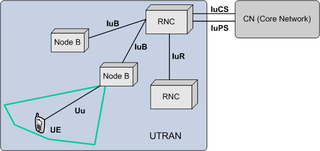
General Packet Radio Service (GPRS) is a packet oriented mobile data standard on the 2G and 3G cellular communication network's global system for mobile communications (GSM). GPRS was established by European Telecommunications Standards Institute (ETSI) in response to the earlier CDPD and i-mode packet-switched cellular technologies. It is now maintained by the 3rd Generation Partnership Project (3GPP).

The protocol stack or network stack is an implementation of a computer networking protocol suite or protocol family. Some of these terms are used interchangeably but strictly speaking, the suite is the definition of the communication protocols, and the stack is the software implementation of them.
The Universal Mobile Telecommunications System (UMTS) is a third generation mobile cellular system for networks based on the GSM standard. Developed and maintained by the 3GPP, UMTS is a component of the International Telecommunication Union IMT-2000 standard set and compares with the CDMA2000 standard set for networks based on the competing cdmaOne technology. UMTS uses wideband code-division multiple access (W-CDMA) radio access technology to offer greater spectral efficiency and bandwidth to mobile network operators.

In IEEE 802 LAN/MAN standards, the medium access control sublayer is the layer that controls the hardware responsible for interaction with the wired, optical or wireless transmission medium. The MAC sublayer and the logical link control (LLC) sublayer together make up the data link layer. Within the data link layer, the LLC provides flow control and multiplexing for the logical link, while the MAC provides flow control and multiplexing for the transmission medium.
The 3rd Generation Partnership Project (3GPP) is an umbrella term for a number of standards organizations which develop protocols for mobile telecommunications. Its best known work is the development and maintenance of:
In the Universal Mobile Telecommunications System (UMTS) and 3GPP Long Term Evolution (LTE), user equipment (UE) is any device used directly by an end-user to communicate. It can be a hand-held telephone, a laptop computer equipped with a mobile broadband adapter, or any other device. It connects to the base station Node B/eNodeB as specified in the ETSI 125/136-series and 3GPP 25/36-series of specifications. It roughly corresponds to the mobile station (MS) in GSM systems.
Non-access stratum (NAS) is a functional layer in the UMTS and LTE wireless telecom protocol stacks between the core network and user equipment. This layer is used to manage the establishment of communication sessions and for maintaining continuous communications with the user equipment as it moves. The NAS is defined in contrast to the Access Stratum which is responsible for carrying information over the wireless portion of the network. A further description of NAS is that it is a protocol for messages passed between the User Equipment, also known as mobiles, and Core Nodes that is passed transparently through the radio network. Examples of NAS messages include Update or Attach messages, Authentication Messages, Service Requests and so forth. Once the User Equipment (UE) establishes a radio connection, the UE uses the radio connection to communicate with the core nodes to coordinate service. The distinction is that the Access Stratum is for dialogue explicitly between the mobile equipment and the radio network and the NAS is for dialogue between the mobile equipment and core network nodes. For LTE, the Technical Standard for NAS is 3GPP TS 24.301.
+- – - – - -+ +- – - – - – -+ | HTTP | | Application | +- – - – - -+ +- – - – - – -+ | TCP | | Transport | +- – - – - -+ +- – - – - – -+ | IP | | Internet | +- – - – - -+ +- – - – - – -+ | NAS | | Network | +- – - – - -+ +- – - – - – -+ | AS | | Link | +- – - – - -+ +- – - – - – -+ | Channels | | Physical | +- – - – - -+ +- – - – - – -+
4G is the fourth generation of broadband cellular network technology, succeeding 3G, and preceding 5G. A 4G system must provide capabilities defined by ITU in IMT Advanced. Potential and current applications include amended mobile web access, IP telephony, gaming services, high-definition mobile TV, video conferencing, and 3D television.
Wireless wide area network (WWAN), is a form of wireless network. The larger size of a wide area network compared to a local area network requires differences in technology. Wireless networks of different sizes deliver data in the form of telephone calls, web pages, and video streaming.
The IEEE 802.21 refers to Media Independent Handoff (MIH) and is an IEEE standard published in 2008. The standard supports algorithms enabling seamless handover between wired and wireless networks of the same type as well as handover between different wired and wireless network types also called Media independent handover (MIH) or vertical handover. Vertical handover was first introduced by Mark Stemn and Randy Katz at U C Berkeley. The standard provides information to allow handing over to and from wired 802.3 network to wireless 802.11, 802.15, 802.16, 3GPP and 3GPP2 networks through different handover mechanisms.

UTRAN is a collective term for the network and equipment that connects mobile handsets to the public telephone network or the Internet. It contains the base stations, which are called Node B's and Radio Network Controllers (RNCs) which make up the UMTS radio access network. This communications network, commonly referred to as 3G, can carry many traffic types from real-time Circuit Switched to IP based Packet Switched. The UTRAN allows connectivity between the UE and the core network.

E-UTRA is the air interface of 3rd Generation Partnership Project (3GPP) Long Term Evolution (LTE) upgrade path for mobile networks. It is an acronym for Evolved Universal Mobile Telecommunications System (UMTS) Terrestrial Radio Access, also referred to as the 3GPP work item on the Long Term Evolution (LTE) also known as the Evolved Universal Terrestrial Radio Access (E-UTRA) in early drafts of the 3GPP LTE specification. E-UTRAN is the initialism of Evolved UMTS Terrestrial Radio Access Network and is the combination of E-UTRA, user equipment (UE), and E-UTRAN Node B or Evolved Node B (eNodeB).

High Speed Packet Access (HSPA) is an amalgamation of two mobile protocols, High Speed Downlink Packet Access (HSDPA) and High Speed Uplink Packet Access (HSUPA), that extends and improves the performance of existing 3G mobile telecommunication networks using the WCDMA protocols. A further improved 3GPP standard, Evolved High Speed Packet Access, was released late in 2008 with subsequent worldwide adoption beginning in 2010. The newer standard allows bit-rates to reach as high as 337 Mbit/s in the downlink and 34 Mbit/s in the uplink. However, these speeds are rarely achieved in practice.
A wide variety of different wireless data technologies exist, some in direct competition with one another, others designed for specific applications. Wireless technologies can be evaluated by a variety of different metrics of which some are described in this entry.
Wireless Application Protocol (WAP) is a technical standard for accessing information over a mobile wireless network. A WAP browser is a web browser for mobile devices such as mobile phones that use the protocol. Introduced in 1999, WAP achieved some popularity in the early 2000s, but by the 2010s it had been largely superseded by more modern standards. Almost all modern handset internet browsers now fully support HTML, so they do not need to use WAP markup for web page compatibility, and therefore, most are no longer able to render and display pages written in WML, WAP's markup language.
The Radio Resource Control (RRC) protocol is used in UMTS, LTE and 5G on the Air interface. It is a layer 3 protocol used between UE and Base Station. This protocol is specified by 3GPP in TS 25.331 for UMTS, in TS 36.331 for LTE and in TS 38.331 for 5G New Radio. RRC messages are transported via the PDCP-Protocol.
System Architecture Evolution (SAE) is the core network architecture of mobile communications protocol group 3GPP's LTE wireless communication standard.

In telecommunications, Long-Term Evolution (LTE) is a standard for wireless broadband communication for mobile devices and data terminals, based on the GSM/EDGE and UMTS/HSPA technologies. It increases the capacity and speed using a different radio interface together with core network improvements. LTE is the upgrade path for carriers with both GSM/UMTS networks and CDMA2000 networks. The different LTE frequencies and bands used in different countries mean that only multi-band phones are able to use LTE in all countries where it is supported.
The UMTS channels are communication channels used by third generation (3G) wireless Universal Mobile Telecommunications System (UMTS) networks. UMTS channels can be divided into three levels:
Long Term Evolution (LTE) telecommunications networks use several frequency bands with associated bandwidths.






